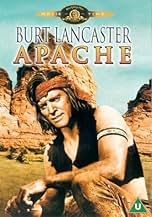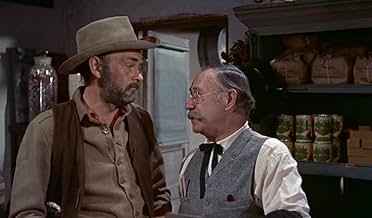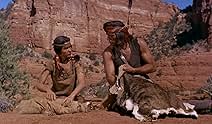CALIFICACIÓN DE IMDb
6.3/10
5.2 k
TU CALIFICACIÓN
Massai, un guerrero apache, se niega a dejar que lo reasenten en una reserva de Florida y escapa de sus captores y regresa a su tierra natal para convertirse en un granjero pacífico.Massai, un guerrero apache, se niega a dejar que lo reasenten en una reserva de Florida y escapa de sus captores y regresa a su tierra natal para convertirse en un granjero pacífico.Massai, un guerrero apache, se niega a dejar que lo reasenten en una reserva de Florida y escapa de sus captores y regresa a su tierra natal para convertirse en un granjero pacífico.
Charles Bronson
- Hondo
- (as Charles Buchinsky)
Paul E. Burns
- General Store Proprietor
- (sin créditos)
Lonnie Burr
- Indian Boy
- (sin créditos)
John George
- Shoeshine Man
- (sin créditos)
Anne Kunde
- Townswoman Leaving Trading Post
- (sin créditos)
Rory Mallinson
- Citizen Noticing Handcuffs
- (sin créditos)
Mort Mills
- Sergeant of the Guard Fort.
- (sin créditos)
Dick Rich
- Loafing Trooper
- (sin créditos)
Steve Rowland
- Teenage Bully in Street
- (sin créditos)
- Dirección
- Guionistas
- Todo el elenco y el equipo
- Producción, taquilla y más en IMDbPro
Argumento
¿Sabías que…?
- TriviaMassai was born to Little Sun and White Shadow at Mescal Mountain, Arizona, near Globe. He later met Geronimo, who was recruiting Apaches to fight American soldiers. He also knew the Apache Kid. The policy in Arizona at the time was to exterminate hostile Apaches. Many Apache warriors fought for their people and traditions, fleeing and waging effective guerrilla warfare against their enemies.
Massai escaped over the border to Mexico, eventually settling in the Sierra Madre mountains in Sonora Mexico with a camp of rebellious Chiricahuas who had refused to surrender with Geronimo. Nothing is known of his final days.
- ErroresAbout 16 minutes into the movie as Massai (Burt Lancaster) is fleeing from the white mob through a hotel corridor you can see an unlit electric 'EXIT' sign visible in the hallway at the top of the shot.
- Créditos curiososOpening credits: This is the story of Massai, the last Apache warrior. It has been told and re-told until it has become one of the great legends of the Southwest. It began in 1886 with Geronimo's surrender.
- ConexionesReferenced in Tal como somos (1956)
Opinión destacada
RELEASED IN 1954 and directed by Robert Aldrich, "Apache" is based on the real-life story of Massai (Burt Lancaster), a Chiricahua Apache who was exiled with other Apaches to a reservation in Florida to be held with Geronimo and Chihuahua, but he escapes the train somewhere near St. Louis and travels 1200 miles back to the Mescalero Apache tribal area, conducting one-man raids near what is now the Arizona-New Mexican border. John McIntire plays the chief of scouts commissioned to capture Massai while Charles Bronson (Buchinsky) is on hand as an Apache scout. Jean Peters plays an Apache babe who, in real life, was Zanagoliche.
Massai actually escaped the prison train with a Tonkawa Native named Gray Lizard and they traveled the long journey back by foot together, eventually parting company in Southeastern Arizona. Gray Lizard is, unfortunately, completely omitted in the film.
To enjoy this movie you have to look past Lancaster in the lead role or, at least, imagine him to look more like a real Apache. But, keep this in mind: Since Massai is the sympathetic protagonist of the story the movie would've never been made in the early 50s without a known Hollywood star playing the role. Why? Simple: Producers needed to attract viewers in order for the film to make money. Actually, Lancaster isn't too unbelievable in the role, as long as you can disregard his blue eyes. Unfortunately babelicious Peters looks way too European to play an Apache squaw, even though they tried to hide it by darkening her skin. On the positive side, there are a lot of real Natives in peripheral roles.
The whole first act is great as Massai is a fish-out-of-water in the city of St. Louis. Unfortunately there are dull stretches in the second and third acts. Nevertheless, "Apache" was better than I thought it would be and inspired me to look up the real-life Massai. It was also a hit at the box office despite falling into relative obscurity since then. The score is surprisingly bearable for an old Western.
"Apache" made Native Americans (who aren't really 'native' since their ancestors emigrated from Asia) sympathetic characters in cinema, along with earlier Westerns, like "Buffalo Bill" (1944), "Fort Apache" (1948) and "Broken Arrow" (1950) and later Westerns, like "The Last Wagon" (1956), "A Man Called Horse" (1970) and "I Will Fight No More Forever" (1975).
THE FILM RUNS 1 hours & 31 minutes and was shot in California, Arizona and New Mexico. WRITERS: James R. Webb wrote the script based on Paul Wellman's novel.
GRADE: B-
Massai actually escaped the prison train with a Tonkawa Native named Gray Lizard and they traveled the long journey back by foot together, eventually parting company in Southeastern Arizona. Gray Lizard is, unfortunately, completely omitted in the film.
To enjoy this movie you have to look past Lancaster in the lead role or, at least, imagine him to look more like a real Apache. But, keep this in mind: Since Massai is the sympathetic protagonist of the story the movie would've never been made in the early 50s without a known Hollywood star playing the role. Why? Simple: Producers needed to attract viewers in order for the film to make money. Actually, Lancaster isn't too unbelievable in the role, as long as you can disregard his blue eyes. Unfortunately babelicious Peters looks way too European to play an Apache squaw, even though they tried to hide it by darkening her skin. On the positive side, there are a lot of real Natives in peripheral roles.
The whole first act is great as Massai is a fish-out-of-water in the city of St. Louis. Unfortunately there are dull stretches in the second and third acts. Nevertheless, "Apache" was better than I thought it would be and inspired me to look up the real-life Massai. It was also a hit at the box office despite falling into relative obscurity since then. The score is surprisingly bearable for an old Western.
"Apache" made Native Americans (who aren't really 'native' since their ancestors emigrated from Asia) sympathetic characters in cinema, along with earlier Westerns, like "Buffalo Bill" (1944), "Fort Apache" (1948) and "Broken Arrow" (1950) and later Westerns, like "The Last Wagon" (1956), "A Man Called Horse" (1970) and "I Will Fight No More Forever" (1975).
THE FILM RUNS 1 hours & 31 minutes and was shot in California, Arizona and New Mexico. WRITERS: James R. Webb wrote the script based on Paul Wellman's novel.
GRADE: B-
- Wuchakk
- 16 ene 2018
- Enlace permanente
Selecciones populares
Inicia sesión para calificar y agrega a la lista de videos para obtener recomendaciones personalizadas
- How long is Apache?Con tecnología de Alexa
Detalles
- Fecha de lanzamiento
- País de origen
- Idioma
- También se conoce como
- Bronco Apache
- Locaciones de filmación
- Productoras
- Ver más créditos de la compañía en IMDbPro
Taquilla
- Presupuesto
- USD 1,240,000 (estimado)
- Tiempo de ejecución1 hora 31 minutos
- Relación de aspecto
- 1.37 : 1
Contribuir a esta página
Sugiere una edición o agrega el contenido que falta

Principales brechas de datos
By what name was Apache (1954) officially released in India in English?
Responda

























